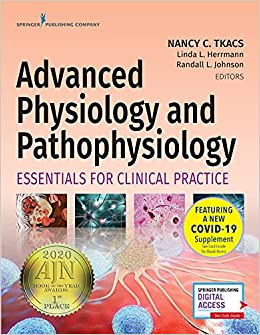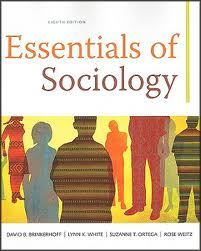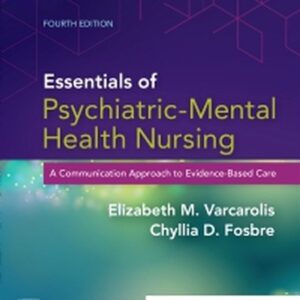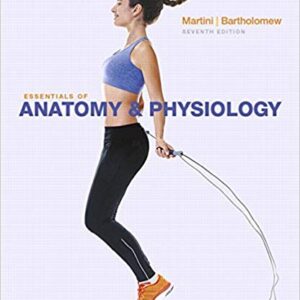Test Bank for Advanced Physiology and Pathophysiology Essentials for Clinical Practice 1st Edition By Tkac
Chapter 1. THE FOUNDATIONAL CONCEPTS OF CLINICAL
PRACTICE
1. The characteristic, localized cardinal signs of acute inflammation include:
A) fever.
B) fatigue.
C) redness.
D) granuloma.
2. The vascular, hemodynamic stage of acute inflammation is initiated by
momentary vasoconstriction followed by vasodilation that causes localized:
A) bleeding.
B) congestion.
C) pale skin.
D) coolness.
3. The cellular stage of acute inflammation is marked by the movement of
leukocytes into the area. Which of the following cells arrives early in great
numbers?
A) Basophils
B) Lymphocytes
C) Neutrophils
D) Platelets
4. The phagocytosis process involves three distinct steps. What is the initial
step in the process?
A) Engulfment
B) Intracellular killing
C) Antigen margination
D) Recognition and adherence
5. Which of the following mediators of inflammation causes increased capillary
permeability and pain?
A) Serotonin
B) Histamine
C) Bradykinin
D) Nitric oxide
6. Inflammatory exudates are a combination of several types. Which of the
following exudates is composed of enmeshed necrotic cells?
A) Serous
B) Fibrinous
C) Suppurative
D) Membranous
7. The acute-phase systemic response usually begins within hours of the onset
of inflammation and includes:
A) fever and lethargy.
B) decreased C-reactive protein.
C) positive nitrogen balance.
D) low erythrocyte sedimentation rate.
8. In contrast to acute inflammation, chronic inflammation is characterized by
which of the following phenomena?
A) Profuse fibrinous exudation
B) A shift to the left of granulocytes
C) Metabolic and respiratory alkalosis
D) Lymphocytosis and activated macrophages
9. Exogenous pyrogens (interleukin-1) and the presence of bacteria in the blood
lead to the release of endogenous pyrogens that:
A) stabilize thermal control in the brain.
B) produce leukocytosis and anorexia.
C) block viral replication in cells.
D) inhibit prostaglandin release.
10 An older adult patient has just sheared the skin on her elbow while attempted
. to boost herself up in bed, an event that has precipitated acute inflammation
in the region surrounding the wound. Which of the following events will
occur during the vascular stage of the patients inflammation?
A) Outpouring of exudate into interstitial spaces
B) Chemotaxis
C) Accumulation of leukocytes along the epithelium
D) Phagocytosis of cellular debris
11 Which of the following individuals most likely has the highest risk of
. experiencing chronic inflammation?
A) A patient who has recently been diagnosed with type 2 diabetes
B) A patient who is a carrier of an antibiotic-resistant organism
C) A patient who is taking oral antibiotics for an upper respiratory infection
D) A patient who is morbidly obese and who has a sedentary lifestyle
12 Which of the following core body temperatures is within normal range?
.
A) 35.9C (96.6F)
NURSING TEST BANK
B) 38.0C (100.4F)
C) 35.5C (95.9F)
D) 37.3C (99.1F)
13 A postsurgical patient who is recovering in the postanesthetic recovery unit
. states that she is freezing cold. Which of the following measures is likely to
be initiated in the patient’s hypothalamus in an effort to reduce heat loss?
A) Opening of arteriovenous (AV) shunts
B) Reduced exhalation of warmed air
C) Contraction of pilomotor muscles
D) Decreased urine production
14 An elderly patient is dressed only in a hospital gown and complains of a
. draft in her room. Consequently, she has requested a warm blanket while she
sits in her wheelchair. Which of the following mechanisms of heat loss is
most likely the primary cause of her request?
A) Evaporation and conduction
B) Radiation and convection
C) Conduction and convection
D) Convection and evaporation
15 Which of the following pathophysiologic processes are capable of inducing
. the production of pyrogens? Select all that apply.
A) Acute inflammation
B) Obesity
C) Myocardial infarction
D) Malignancy
E) Renal failure
16 Which of the following patients is most likely to be susceptible to
. developing a neurogenic fever?
A) A patient who has stage II Alzheimer disease
B) A patient who has sustained a head injury in a bicycle crash
C) A patient who has become delirious after the administration of a
benzodiazepine
D) A patient who has begun taking a selective serotonin-reuptake inhibitor
(SSRI) for the treatment of depression
17 Patients are commonly administered antipyretics when their oral temperature
. exceeds 37.5C (99.5F). Which of the following statements related to the
rationale for this action is most accurate?
A) Temperatures in excess of 37.5C (99.5F) can result in seizure activity.
B) Lower temperatures inhibit the protein synthesis of bacteria.
C) There is little empirical evidence for this treatment modality.
D) Most common antipyretics have been shown to have little effect on core
temperature.
18 A patient has sought care because of recent malaise and high fever. Upon
. assessment, the patient states that his current fever began two days earlier,
although he states that for the last 2 weeks he is in a cycle of high fever for a
couple of days followed by a day or two of normal temperature. Which of
the following fever patterns is this patient experiencing?
A) Recurrent fever
B) Remittent fever
C) Sustained fever
D) Intermittent fever
19 A febrile, 3-week-old infant has been brought to the emergency department
. by his parents and is currently undergoing a diagnostic workup to determine
the cause of his fever. Which of the following statements best conveys the
the rationale for this careful examination?
A) The immature hypothalamus is unable to perform normal
thermoregulation.
B) Infants are susceptible to serious infections because of their decreased
immune function.
C) Commonly used antipyretics often have no effect on the core temperature
of infants.
D) Fever in neonates is often evidence of a congenital disorder rather than an
infection.
20 An 84-year-old patient’s blood cultures have come back positive, despite the. fact that his oral temperature has remained within the normal range. Which of
the following phenomena underlies the alterations in fever response that
occur in the elderly?
A) Disturbance in the functioning of the thermoregulatory center
B) Increased heat loss by evaporation
C) The presence of comorbidities that are associated with lowered core
temperature
D) Persistent closure of arteriovenous shunts
Answer Key
1. C
2. B
3. C
4. D
5. C
6. D
7. A
8. D
9. B
10 A
11 D
12 D
13 C
14 B
15 A, C, D
16 B
17 C
18 D
19 B
20 A




